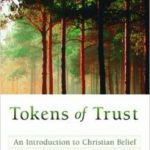Rowan Williams: Tokens of Trust, Pt. 2
I believe in one holy catholic and apostolic church
To be in the church is not to stand under the arches of an old building, or to become a club member. It is to step into the life of the Trinity, which, as we saw in the last part, is the life of communion—of sharing.
Williams sings that new pattern of life in which we breathe the air of Christ, the Holy Spirit.(105) We achieve a peace in the Church which is not the absence of activity, but more an unbroken flow. We achieve a ‘dynamic equilibrium,’ as we are caught in a web of relationships. Indeed this is, perhaps, something like swimming:
To be in the Church is to be in the middle of that divine life, which Jesus uncovers for us—the outpouring and returning and sharing, gift and response and renewed overflow of giving, the threefold rhythm of love, Father, Son and Spirit. Those are the waves that surge around you as you try to live the life of discipleship, which is not the following of a distant figure in the past or simple obedience to a distant figure in the present, but participation in the rhythm that sustains the universe. When we think of life in the Church, perhaps we ought to think less in terms of signing up to a society and more in terms of swimming in an overwhelming current of divine loving activity…. (136)
One might wonder whether “swimming” in the sea of the Church better describes the life of a parish priest than the average church-goer. Still, Williams’ point is that the Church is about communion.
It is the Body of Christ, and a “community of universal giftedness.” (106) For here we are called to believe in the unique gift of the other. We learn how to be for each other and, in so doing, live fully as ourselves: there is no thinning of our personality, but an amplification. Each depends radically upon the other; each is supported by the other’s gifts and, if the other is held back, we are all held back. We grow only together (107).
The new society is bound together especially at the Eucharist. At the meal of thanksgiving, Jesus shares with us his God-soaked humanity (his “presence”). He becomes our food and drink–our common or shared life. And he who shares his life with us enables us to share. We are drawn into an economy of gift. Here is something precious and counter-cultural in a world where nothing is given, but for a price.
This receptivity to divine gift imparts a future-orientation to the church: it becomes the advance-guard of society, not reactionary, but supremely relevant. In the Eucharist, alike with all works of charity, we see the future:
“This is the future, this is the sign of a ‘peaceable kingdom,’ a realm in which God directs, shapes and draws … humanity and the whole material world [to] speak clearly of his glory.”
I look for the resurrection of the dead
The heavenward-orientation of the Church is not merely an openness to the future, but also an openness to the past: both temporal dimensions are made present–as indeed at the anamnesis of the Eucharist. All the saints and ancient ones and sages celebrate with us. So Williams turns to the resurrection.
He rejects the idea that there is a substantial, immortal soul which floats free of the body after death, and also the common medieval view that it is separated during the ‘intermediate state’ before the general resurrection. The hope of eternal life, he says, requires some sort of embodiment and memory upon death, for if God holds us in life, God does obliterate who we are—beings in community and context. God holds on to every aspect of us, not just a specially protected, ‘immortal’ bit of us. (143)
Indeed we should expect rather a recovery of identity and selfhood. Yet this will also be a potentially painful exposure to the truth:
“…death is a nakedness to which we must all come, a spiritual stripping, as we are confronted by God. The identities we have made, that we have pulled around ourselves like a comfortable dressing-gown or a smart suit [146] will dissolve, and what is deepest in us, what we most want, what we most care about, will be laid bare.” (147)
Finally, the school of truth is prayer. In contemplation we prepare ourselves for our eternal dwelling-place:
“we are growing into mature life—growing into a grateful and secure awareness of ourselves that is always reaching out in what may feel like a blind love and searching for an Other beyond words and ideas, receiving always the influx of gift that makes us what we are, yet normally unable to say quite how this works. … We can only trust that growth is happening; we know that it is happening only as we test our slowly expanding capacity to face truth, to accept our failures, to go on questioning ourselves because we trust that God will no let go of us.” (158)
Williams’ work is a real catechetical resource. It was written amid the heat of the so-called “new atheism,” around 2006. It could be a salve to the sort of pains thoughtful young people carry.

